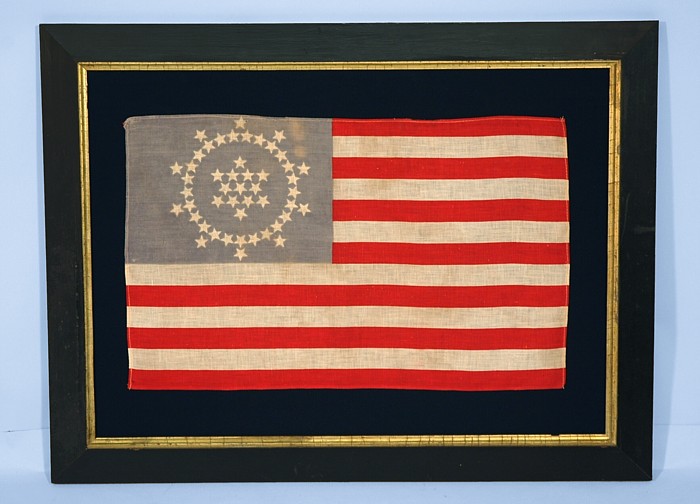
| |
RARE WHIPPLE PATTERN 48 STAR AMERICAN PARADE FLAG |
|
| Available: |
Sold |
| Frame Size (H x L): |
23.75" x 31.25" |
| Flag Size (H x L): |
14" x 22.75" |
|
| Description....: |
|
| 48 STARS, WHIPPLE PATTERN, 1909-1912,
A RARE AND HIGHLY DESIRED EXAMPLE:
Many people are not aware that for the first 135-year existence of the Stars & Stripes, there was no official way to configure its stars. It was not until 1912 that an official design was adopted, following an executive order of President Taft. Sometime beforehand, around 1909, it became clear that such a circumstance might occur. Two more stars would be added for the remaining Western Territories that had not yet become states (New Mexico and Arizona), and the flag would again change. At this time, Philadelphian by the name of Wayne Whipple, who had written a book on the American flag in 1904, decided that he wanted to be the man who designed it.
Many designs were probably brought forth, but it is not clear if a list of them survives. Possibly they were lost, forgotten, or simply never recorded. But Wayne Whipple was one person among the interested artists who would proceed to solidify his name in history, designing and contracting flags to be made in what is now known as the "Whipple" pattern. He distributed these small parade flags liberally in pursuit of his goal, which were printed on cotton or silk, taking them to rallies and mailing them to influential parties with many letters of solicitation. Surviving examples, however, are extremely scarce.
The star configuration Whipple devised includes 13 stars in the center for the 13 original colonies, arranged in a 6-pointed Great Star or Star of David pattern. According to Whipple, this had no religious connotations, but instead was simply a logical way to display 13 stars in a star-shaped formation. Surrounding the Great Star is a wreath of 25 stars the represent the number of additional states that had joined the Union by the time of the nation's 100-year anniversary in 1876. And around this is a wreath of 10 stars, widely spaced. Stars could be easily added to the outer wreath without changing the basic design, which was why Whipple felt that it would be not only beautiful, but functional.
There is to date only one known example of a Whipple pattern flag with sewn construction, which was presented to President Taft by Whipple in 1913, then returned to Whipple and descended through the Whipple family. All the rest are printed parade flags (and tapered pennants). According to personal letters that were written by Whipple, along with correspondence between Whipple, the White House, and the War Department, Presidents Roosevelt and Taft both approved of and endorsed Whipple's design. Whipple was actually friends with both men yet campaigned with Roosevelt in 1912. When it came to the final selection of an official configuration, however, the War Department's recommendations drove Taft to select the rectilinear pattern of 6 rows of 8 stars.
Mounting: The flag has been stitched to 100% cotton, black in color. The background fabric has been washed to reduce excess dye. An acid-free agent was added to the wash to further set the dye and the fabric was heat-treated for the same purpose. The flag was then placed in a black painted molding of the 1830-1850 period with a very unusual profile and a gilded liner. Spacers keep the textile away from the glass, which is u.v. protective.
Condition: There is some fading of the blue canton toward grey, accompanied by small bleached areas. |
|
|
|
| Collector Level: |
Advanced Collectors and the Person with Everything |
|
| Flag Type: |
Parade flag |
|
| Star Count: |
48 |
|
| Earliest Date of Origin: |
1909 |
|
| Latest Date of Origin: |
1913 |
|
| State/Affiliation: |
Arizona |
|
| War Association: |
|
|
| Price: |
No |
|
| |
Views: 3308 |
|
|
|

